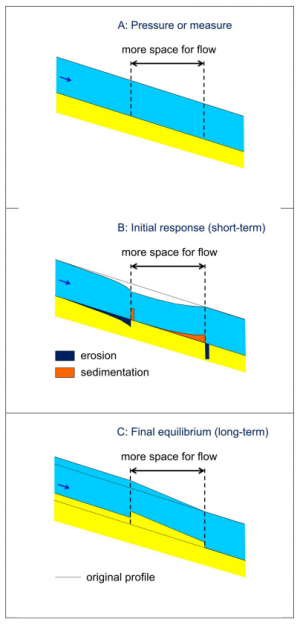Difference between revisions of "Effects of giving more space to the flow"
| Line 3: | Line 3: | ||
The longitudinal profiles of Figures A to C visualize how more space for the flow affects the main channel of a river reach. The vertical scale is exaggerated with respect to the horizontal scale. The reach can be kilometres to tens of kilometres long.<br /> | The longitudinal profiles of Figures A to C visualize how more space for the flow affects the main channel of a river reach. The vertical scale is exaggerated with respect to the horizontal scale. The reach can be kilometres to tens of kilometres long.<br /> | ||
| − | The intervention implies essentially that more space is given to the river over a certain length (A). The immediate effect is a decrease in water levels along the river (B). This decrease is not uniform, but varies from place to place. As a consequence, flow velocities differ from place to place too. The water levels and flow velocities can be calculated using 1D analytical models for gradually-varied flow or 1D numerical hydrodynamic models. The variations in flow velocity and, hence, the variations in the capacity to transport sediment give rise to a pattern of initial erosion and sedimentation along the river (B) that can be calculated using 1D analytical models for morphology on short time scales or 1D numerical morphodynamic models. Erosion over a relatively long distance occurs upstream of the intervention, whereas punctuated local sedimentation occurs immediately downstream of the entrance of the modified part of the river. This sedimentation advances downstream as a shock wave. Sedimentation occurs also further downstream, followed by punctuated local erosion immediately downstream of the exit of the modified part of the river.<br /> | + | The intervention implies essentially that more space is given to the river over a certain length (A). The immediate effect is a decrease in water levels along the river (B). This decrease is not uniform, but varies from place to place. As a consequence, flow velocities differ from place to place too. The water levels and flow velocities can be calculated using [[1D analytical models for gradually-varied flow]] or [[1D numerical hydrodynamic models]]. The variations in flow velocity and, hence, the variations in the capacity to transport sediment give rise to a pattern of initial erosion and sedimentation along the river (B) that can be calculated using [[1D analytical models for morphology on short time scales]] or [[1D numerical morphodynamic models]]. Erosion over a relatively long distance occurs upstream of the intervention, whereas punctuated local sedimentation occurs immediately downstream of the entrance of the modified part of the river. This sedimentation advances downstream as a shock wave. Sedimentation occurs also further downstream, followed by punctuated local erosion immediately downstream of the exit of the modified part of the river.<br /> |
Eventually, in the long run, the river reaches a new morphological equilibrium without further trends of erosion or sedimentation (C). Local and upstream bed and water levels have become higher than at the start of the intervention. This means that the response of the river bed is particularly complex upstream of the intervention: erosion on a short term but sedimentation on a long term.<br /> | Eventually, in the long run, the river reaches a new morphological equilibrium without further trends of erosion or sedimentation (C). Local and upstream bed and water levels have become higher than at the start of the intervention. This means that the response of the river bed is particularly complex upstream of the intervention: erosion on a short term but sedimentation on a long term.<br /> | ||
Latest revision as of 14:33, 11 December 2015
Contents
Description
The longitudinal profiles of Figures A to C visualize how more space for the flow affects the main channel of a river reach. The vertical scale is exaggerated with respect to the horizontal scale. The reach can be kilometres to tens of kilometres long.
The intervention implies essentially that more space is given to the river over a certain length (A). The immediate effect is a decrease in water levels along the river (B). This decrease is not uniform, but varies from place to place. As a consequence, flow velocities differ from place to place too. The water levels and flow velocities can be calculated using 1D analytical models for gradually-varied flow or 1D numerical hydrodynamic models. The variations in flow velocity and, hence, the variations in the capacity to transport sediment give rise to a pattern of initial erosion and sedimentation along the river (B) that can be calculated using 1D analytical models for morphology on short time scales or 1D numerical morphodynamic models. Erosion over a relatively long distance occurs upstream of the intervention, whereas punctuated local sedimentation occurs immediately downstream of the entrance of the modified part of the river. This sedimentation advances downstream as a shock wave. Sedimentation occurs also further downstream, followed by punctuated local erosion immediately downstream of the exit of the modified part of the river.
Eventually, in the long run, the river reaches a new morphological equilibrium without further trends of erosion or sedimentation (C). Local and upstream bed and water levels have become higher than at the start of the intervention. This means that the response of the river bed is particularly complex upstream of the intervention: erosion on a short term but sedimentation on a long term.
The longitudinal profiles in the diagrams provide a simplified picture. They do not include the response of channel width, bed sediment composition or vegetation. Nonetheless, they offer the key to understanding the relation between local pressures or measures and their effects far upstream and downstream.
Related Pressures
Related Measures
Related Hymo quality elements
- Quantity and dynamics of water flow (Class: Hydrological regime)
- River depth and width variation (Class: Morphological conditions)
Related Biological quality elements
- No Biological Quality Elements apply to this tool.
